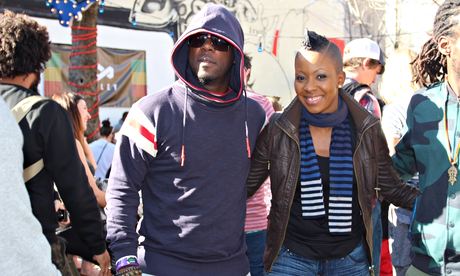
Like a net that's been dredged across the Atlantic, the curve of the Caribbean islands has caught a mixed shoal of musical styles, as first slaves then expats moved back and forth between the Americas, Europe and Africa. There's reggae and dancehall, of course, but also bastardised French ballroom music in Martinique's biguine, or kadans, a Haitian take on mérengue. Trinidad and Tobago's own blend is soca, where Indian rhythms are fused with calypso and house.
There days soca is largely full of blandly uplifting exhortations to wind your waistline and wave your arms. Yet it once contained an element of calypso's social realism, and Bunji Garlin, the self-styled "Viking of Soca", wants to take it back to its roots. His track Differentology was the Caribbean crossover of 2013, and it's being reissued this week in the UK.
"The chords were so sad, but still they couldn't resist it," he says down the line from Trinidad a few days after this year's carnival. "It was one of the few socas in the history of our music that everyone was able to sing in a matter of three days' time. That says a lot about the quality of the material that is being put out; if you release a song that is taking a month and a half to get in your bloodstream, something is wrong."
As well as the revolution in melody, Bunji, now 35, set out as a 20-year-old to reinvest Trinidadian music with meaning. "Calypso was always the music that told the story of the day – it was regarded as the poor man's newspaper," he says. "It would explain the story of what happened in politics, or what happened on the streets. The music had moved so far away from that."
Garlin and his peers were kept away from the sexually suggestive music of their own island by being sent to church camps during carnival season. Yet he was exposed to pop from outside the Caribbean, "because parents couldn't understand the content of what was coming from abroad, so there was no harm." Armed with a cosmopolitan outlook, he eventually became part of the nascent "ragga soca" scene at the turn of the century. "We came on the scene so aggressive, it was like a threat – and soca is not known as threatening music. It is known as happy music, where you release your stress and problems. But we came with serious topics."
'I came on to the scene innocent, and you never think you could offend so many people, to the point where they're creating petitions to get you out of the industry'
Bunji speaks with the same declarative, street-hawking tone as calypso greats such as Lord Kitchener, his voice lilting up and down with wry humour and bursts of pride, and like them he takes stock of everyday travails. He puts the "soca" in "socially conscious" via tracks such as Down in the Ghetto, which disputes his government's housing policy, and Licks (Yuh Want to Rape), which goes after child molesters and rapists, still with the style's manically peppy demeanour. The soca old guard, who went for "a less in-your-face approach and a more in-your-waist approach", reacted angrily. "We're in a society where if we could have things remain the same for a hundred years we would prefer it that way," he says. "They would have radio station call-ins for months, saying this shouldn't be allowed to exist and that does a lot to you as a young artist. You're never prepared to hear something like that. I came on to the scene innocent, and you never think you could offend so many people, to the point where they're creating petitions to get you out of the industry."
Undeterred, Garlin grew a young fanbase who now track him from show to show, even during the hectic carnival season. "One night this year we had nine band shows from 6pm to 7am, and each set is an hour or an hour and a half," he says. "What baffles me is that we'll leave one venue and go to the next, and half the crowd from the first show is in the crowd in the second – and it's exactly the same high-pitched frenzy. There were people who saw us 70 or 80 times for carnival, and the reaction was the exact same way." An inspiration for maintaining this energy is his wife, fellow soca star Fay-Ann Lyons. "She's a very strong individual when it comes to music, and she's very intelligent as well: she has figured out how to go on stage, work 20,000 people and she doesn't have to dress skimpily to do it. She has a masculine approach: she doesn't approach the stage pink, she approaches the stage black! This is a woman who jumps on a cooler cover and crowdsurfs while balancing on it, jumping on it with the microphone, singing and performing. She does that with such ease."
So despite the social themes, this is still music to potentially crowdsurf to, and Bunji's 2014 carnival anthem Truck on the Road exhorts you to "fling your water, fling your beer"; like his Viking namesake, he's as much a hedonist as a leader. "The stage is like a battlefield for me, and every show is like a new territory to conquer," he says with Norse grandeur. "I come in peace, but either way I'm going to give it to you."

